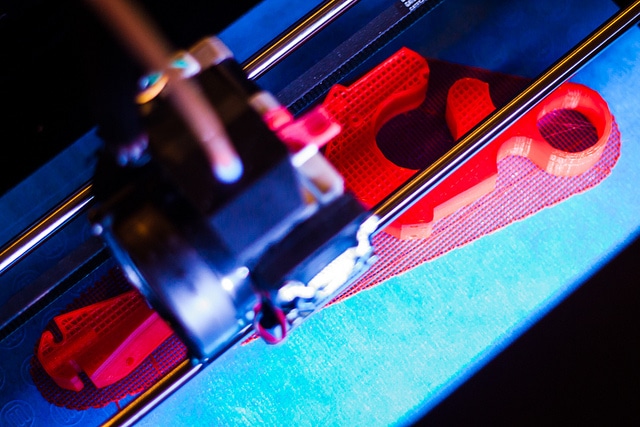Article summary

Recently, a group of people at AO collectively bought a MakerBot Replicator 2. The printer has been going pretty steadily, but not without the teething problems expected in an early-adopter technology.
Poor Extruder Block Design
Makerbot’s stock extruder for the Replicator 2 uses a round delrin plunger mounted on the end of a screw to pinch the filment against the stepper motor’s hobbed wheel to push filament. Delrin has a low enough coefficient of friction that this works great so long as your filament is a constant diameter. In our printing, we’ve found that our extruder occasionaly still skips steps, leaving gaps in the extruded filament.
This delrin plunger is adjustable, but only after removing the print-cooling fan, which is attached with self-tapping screws. It takes quite some time to remove the fan, and the self-tapping screws give you a limited number of removal and replacement cycles.
Thankfully, Makerbot has recently released a community-derived pinch roller design which is theoretically much more tolerant to filament thickness deviations. They even sent us the upgrade kit at no cost when we contacted them. It was installed earlier this week and is working pretty well so far.

Belt Tension Issues
An issue kept appearing in various prints where infill would sometimes not reach the edges of the print in the positive y direction. After running prints through several independent software chains (Makerware with MiracleGrue and Skeinforge, ReplicatorG with Skeinforge and Slic3r) and seeing the same issue, I determined it *must* be either a firmware or a hardware issue.
To try and narrow down the issue, I printed out a 20mm diameter, 20mm height cylinder. The thought was that any axis slope would be very apparent with a pair of digital calipers. When the printed part was measured, I found a minimum diameter of 19.7mm and a maximum of 20.4mm. 0.7mm is way more variance than I was expecting.
Some previous experience with an Ultimaker suggested that this could be a belt tension issue. I went through the belts in the machine and found that the belt connecting the y-axis stepper motor to the gantry system was quite loose. Once I found a 5.5mm socket and extension with which to loosen the two mounting nuts and repositioned the stepper motor, the print improved much more to a .3mm difference.
Still an Early Technology
Makerbot has come a very, very long way in their efforts to bring 3d printing to the masses. When comparing the amount of effort needed to get good prints out of a Cupcake CNC or even a Thing-o-Matic to that required on the Replicator 2, the ease of use is astonishing. The question I ask myself when wondering whether something is ready for the mass market is “Would I be willing to shoulder the technical support load if I gave this to my grandmother?” For the Replicator 2, the answer is a definitive no.
The Makerbot Operators Group is a great place to go for help with issues like these. Have you encountered any odd issues or assembly inconsistencies with your Replicators?
